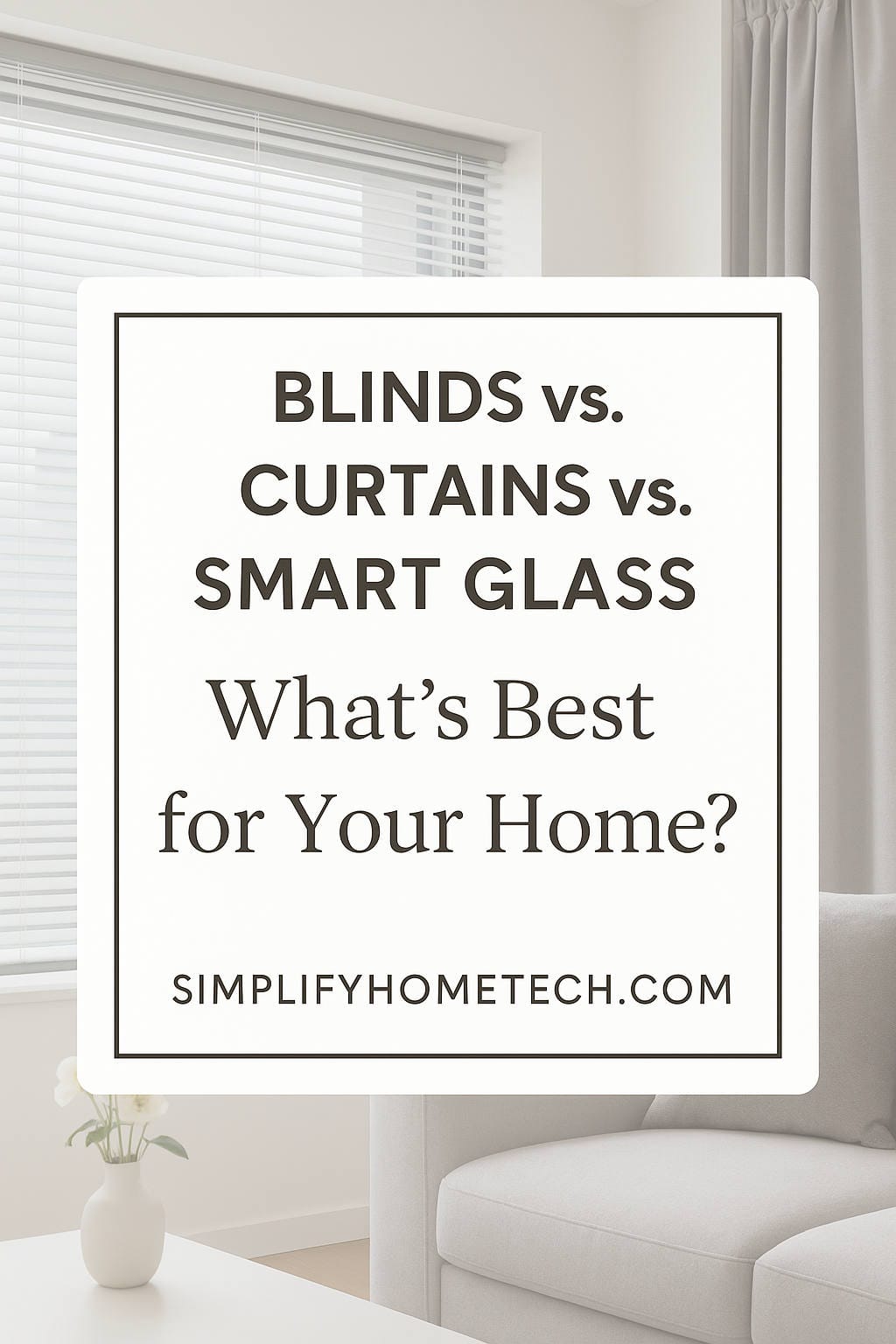When it comes to designing a comfortable, functional, and visually pleasing living space, one often-overlooked element can make a huge impact: window treatments. Whether you’re renovating a home, moving into a new place, or just giving a room a makeover, choosing the right window covering is a key decision. Today, three popular options dominate the conversation: blinds, curtains, and the futuristic smart glass. But which one is the best fit for your home?
In this comprehensive guide, we’ll compare blinds, curtains, and smart glass across categories like aesthetics, privacy, energy efficiency, maintenance, and cost. By the end, you’ll have a clear idea of what works best for your style, lifestyle, and budget.
Understanding the Basics
1. Blinds
Blinds are structured window coverings made from slats, which can be either horizontal or vertical. These slats are usually made from materials like wood, faux wood, aluminum, or vinyl. You can adjust them to let in varying degrees of light and privacy.
Blinds are known for their clean, minimalistic appearance and adaptability, making them a popular choice for modern interiors and functional spaces like kitchens and home offices.
2. Curtains
Curtains are fabric panels hung from a rod above the window. They come in an endless variety of colors, patterns, materials, and lengths, offering near-limitless design possibilities. Curtains can be sheer, allowing diffused light in, or heavy and opaque for complete blackout conditions.
They tend to soften the look of a room, adding texture and warmth, and work well in cozy or traditional settings.
3. Smart Glass
Smart glass, also known as switchable glass or electrochromic glass, is a high-tech window solution that can change its transparency with electricity. With the touch of a button or automation via smart home systems, it can switch from clear to opaque, offering instant privacy without physical coverings.
This sleek, modern option is often found in luxury homes and cutting-edge architecture and is valued for its innovative energy efficiency and convenience.
Aesthetic Appeal and Interior Design Compatibility
Blinds: Sleek and Functional
Blinds provide a minimalist, clean-lined look that blends well with contemporary and functional decor styles. They are available in a wide range of finishes, from natural wood tones to sleek metallics, giving you design flexibility. However, they may feel too stark or utilitarian in spaces that crave softness or character.
Curtains: Timeless and Versatile
Curtains are a decorator’s dream. From airy linens to rich velvets, they bring drama, elegance, and softness to a room. Curtains can complement virtually any design style depending on the fabric and color. They’re also a great way to add seasonal or thematic decor changes with minimal investment.
Smart Glass: Ultra-Modern and Seamless
Smart glass offers an ultra-modern aesthetic that’s ideal for homes with a clean, open, and futuristic feel. It works well in spaces designed with glass walls, panoramic views, or minimalist interiors. Since it lacks physical texture or form, it may feel cold or impersonal in more traditional spaces.
Light Control and Privacy
Blinds
Blinds give you exceptional control over both light and privacy. You can tilt the slats to filter light precisely or pull them up/down entirely. However, they may still let in light through gaps, and over time, the mechanisms can wear down.
Curtains
Curtains can be extremely effective for privacy, especially when using blackout or lined varieties. Sheer curtains let light in while obscuring visibility, and layering gives you flexibility. However, they’re not as adjustable as blinds; it’s more of an open-or-closed situation.
Smart Glass
Smart glass offers instant privacy with a tap or command. When activated, it becomes opaque or tinted, effectively blocking the view from outside. Some versions also offer adjustable tint levels, providing excellent light management without any physical barrier or bulk.
Energy Efficiency and Insulation
Blinds
Blinds offer moderate energy efficiency. While closed, they can reduce solar heat gain and help keep interiors cooler. However, gaps between the slats can limit their insulating capabilities.
Curtains
Thick, lined, or thermal curtains are excellent at maintaining room temperature. In winter, they help keep heat in, and in summer, they block out sun and heat. Curtains offer the most traditional and cost-effective insulation benefits.
Smart Glass
Smart glass shines when it comes to energy efficiency. Advanced models can block infrared and ultraviolet rays, reducing heat transfer and protecting interiors from sun damage. They can help reduce reliance on HVAC systems, particularly in climates with intense sunlight or temperature swings.
Maintenance and Cleaning
Blinds
Blinds are relatively easy to clean but require regular dusting. Depending on the material, they may be prone to bending or breaking over time, especially in homes with pets or children.
Curtains
Curtains need more intensive care. While some are machine-washable, others require dry cleaning. They also attract dust and may hold odors, so regular maintenance is key.
Smart Glass
Smart glass is low-maintenance as it doesn’t involve fabrics or moving slats. Regular glass cleaning is all that’s required. However, if the electronic components fail, professional repair or replacement can be expensive.
Installation and Space Requirements
Blinds
Blinds are relatively simple to install and are suitable for a variety of window shapes and sizes. They don’t take up much space and fit neatly inside window frames, making them ideal for small rooms or minimalistic designs.
Curtains
Curtains need more space and planning. You need to account for rod placement, fabric length, and stack-back (the space curtains take when open). This can make small rooms feel crowded, but it also adds volume and drama to larger spaces.
Smart Glass
Installing smart glass is a specialized job. It involves replacing existing windows with high-tech glass panels and requires electrical wiring. It’s not a DIY project and usually happens during major renovations or new builds.
Smart Home Compatibility
Blinds
Many modern blinds are available with motorization and smart home integration. They can be programmed to open or close on a schedule or controlled via smartphone or voice assistant.
Curtains
Motorized curtain rods bring curtains into the smart home era. These systems can be synced with home automation systems, offering hands-free control and scheduling.
Smart Glass
Smart glass is inherently smart and often comes with built-in integration for automation, timers, and sensors. You can set it to respond to sunlight, time of day, or occupancy.
Cost Comparison
Blinds
Blinds are generally affordable, with basic models starting around $50 per window. Premium materials like real wood or motorization features can push costs higher, but overall, they’re budget-friendly.
Curtains
Curtains vary widely in price depending on fabric, length, and hardware. Expect to pay $100 to $500 per window. Custom drapery and motorized tracks will increase the cost.
Smart Glass
Smart glass is the most expensive option, typically ranging from $500 to over $1,200 per square meter. Installation and electrical setup add to the expense, making it a significant investment.
Durability and Longevity
Blinds
Blinds last 5 to 10 years with proper care. They’re prone to mechanical issues and wear-and-tear in high-use areas but are easily replaceable.
Curtains
Curtains can last many years, especially if they’re lined and cared for properly. Fabric may fade over time, but the structural longevity is excellent.
Smart Glass
Smart glass is built to last, with some systems rated for decades of use. However, electronics and power supply elements could require maintenance or upgrades.
Environmental Impact
Blinds
Look for eco-friendly materials like bamboo or recycled aluminum to reduce environmental impact. Standard plastic blinds are less sustainable.
Curtains
Natural fabrics like cotton, linen, and hemp are more sustainable than synthetic ones. Locally sourced or organic materials can further reduce your carbon footprint.
Smart Glass
Although manufacturing smart glass is energy-intensive, it can reduce household energy use over time. By limiting the need for artificial lighting and climate control, it offers a long-term eco benefit.
Best Applications by Room
| Room | Best Choice | Reason |
|---|---|---|
| Living Room | Curtains or Blinds | Style + light control |
| Bedroom | Blackout Curtains | Privacy + sleep quality |
| Bathroom | Smart Glass | Privacy + moisture resistance |
| Kitchen | Blinds | Easy to clean |
| Home Office | Smart Glass or Blinds | Glare control + professionalism |
| Nursery | Thermal Curtains | Comfort + insulation |
Pros and Cons Summary
Blinds
Pros: Affordable, modern look, adjustable light control, easy to clean
Cons: Limited insulation, can be fragile, less luxurious feel
Curtains
Pros: Soft and stylish, good insulation, huge design variety
Cons: Requires maintenance, takes space, can fade or trap allergens
Smart Glass
Pros: Instant privacy, smart home integration, energy-efficient
Cons: High cost, complex installation, limited tactile appeal
Final Verdict: Which One Should You Choose?
Choosing the right window treatment isn’t about picking the “best” option—it’s about selecting what aligns with your needs, style, and lifestyle.
- Go with blinds if you’re looking for an affordable, low-maintenance solution that offers great light control in kitchens, offices, or rental units.
- Opt for curtains if design and comfort are top priorities, especially in bedrooms or living areas where ambiance and insulation matter.
- Choose smart glass if you want the latest tech and are ready to invest in a clean, automated, and highly efficient solution.
In some homes, a hybrid approach might be ideal. Picture a home office with smart glass windows and decorative curtains framing them, or a kitchen with practical blinds and a nearby breakfast nook with cozy fabric drapes.
Whatever you decide, the right window treatment will elevate your home’s functionality and beauty—so take the time to choose wisely.

